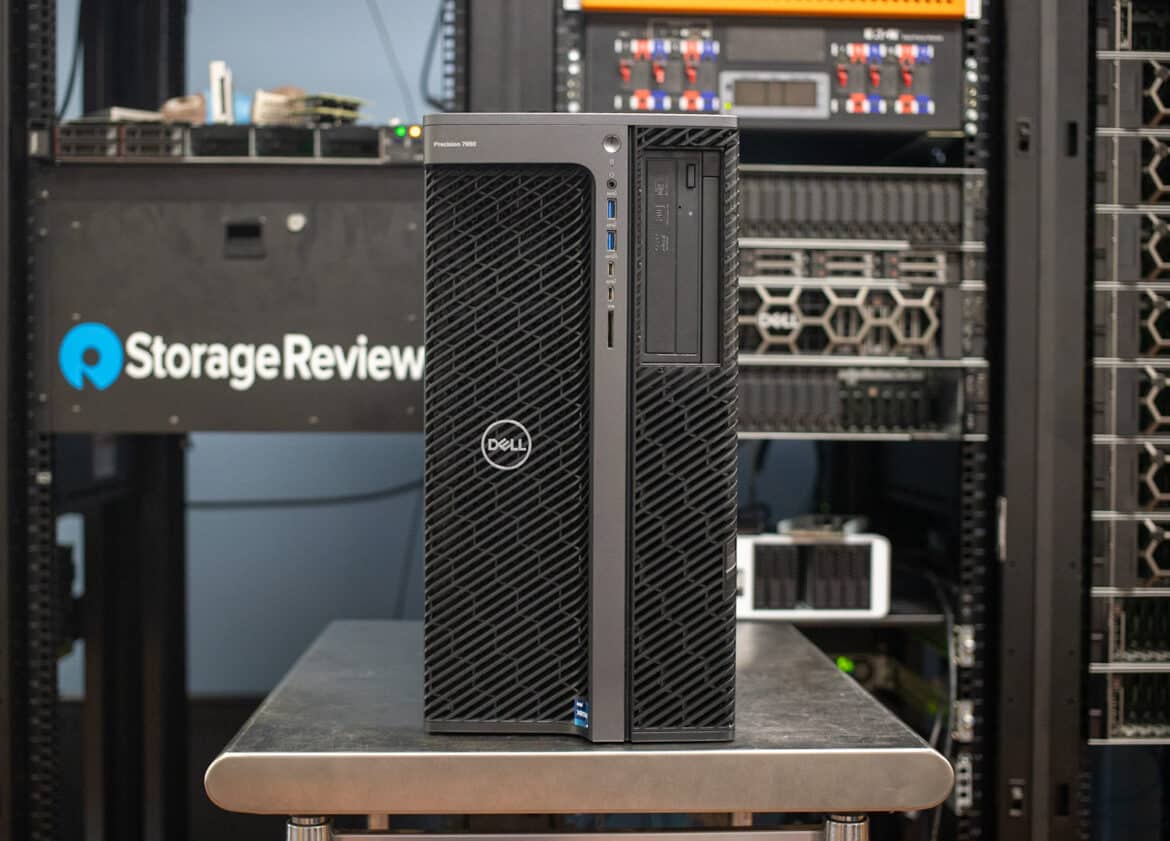Dell has a great lineup of workstations that fit a variety of applications, and the new Precision 7960 is a powerhouse targeted for AI workloads and professional graphics. Replacing the previous generation Precision 7920, the 7960 is the new top dog of the Intel-based Precision workstation family.
Dell has a great lineup of workstations that fit a variety of applications, and the new Precision 7960 is a powerhouse targeted for AI workloads and professional graphics. Replacing the previous generation Precision 7920, the 7960 is the new top dog of the Intel-based Precision workstation family.
Being a step up from the current 7865 model reviewed earlier this year, The 7960 is a direct competitor to machines like the Lenovo Thinkstation P7, and the HP Z8 G5 Fury released earlier this year, offering similar hardware configurations.
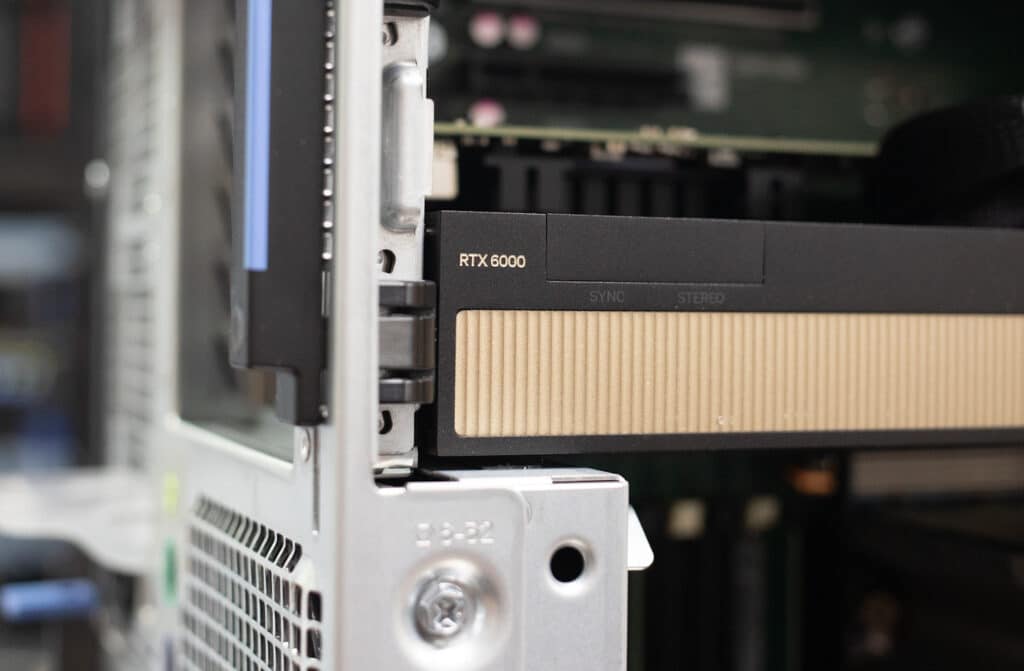
Overview
The Precision 7960 was released as a general professional workstation, but at the same time, it was targeted toward the vastly growing field of Generative AI. This Precision workstation can handle a range of AI tasks with up to four Ada GPUs, resulting in an 80 percent increase compared to the previous generation.
The compact design enables AI developers and data scientists to access a wealth of AI capabilities right at their desks. Like previous generations, Dell offers a desktop and a rackmount variant of the Precision 7960 for added flexibility. Jointly engineered with NVIDIA, Dell brings forward the new inferencing blueprint, Dell Validated Design for Generative AI with NVIDIA, optimizing the deployment and scalability of Generative AI at the enterprise level, which is supported on the Precision workstations and PowerEdge systems.
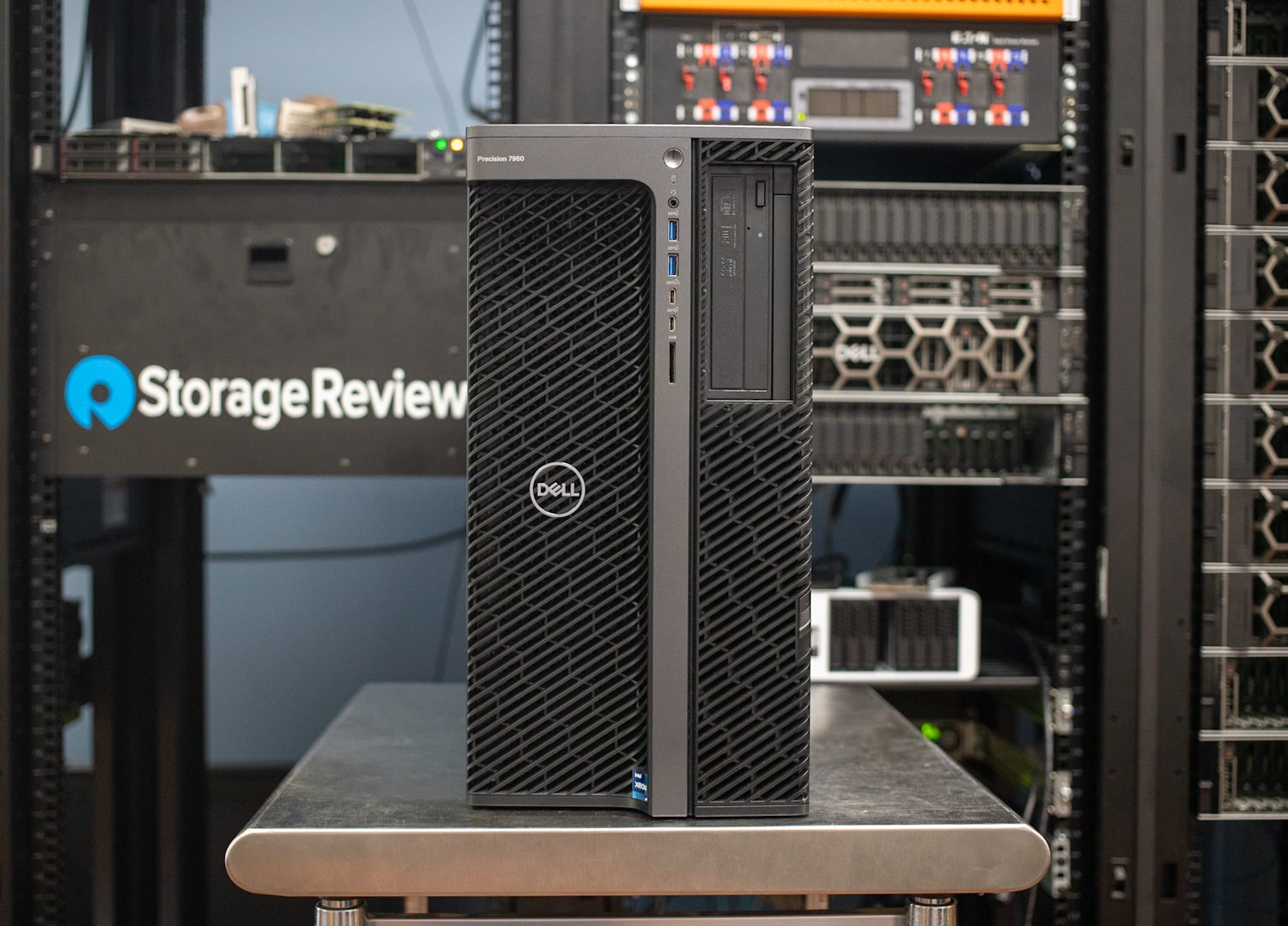
As previously mentioned, this Precision system supports up to 4 of the NVIDIA RTX 6000 Ada GPUs, which currently sits as the best workstation GPU NVIDIA has to offer, bringing unmatched capabilities. The RTX 6000 features 48GB of DDR6, a whopping 18,176 next-generation CUDA cores, 142 third-generation RT cores, and 568 fourth-generation Tensor cores. This card’s performance allows it to deliver incredible performance for AI graphics, rendering, and heavy compute workloads.
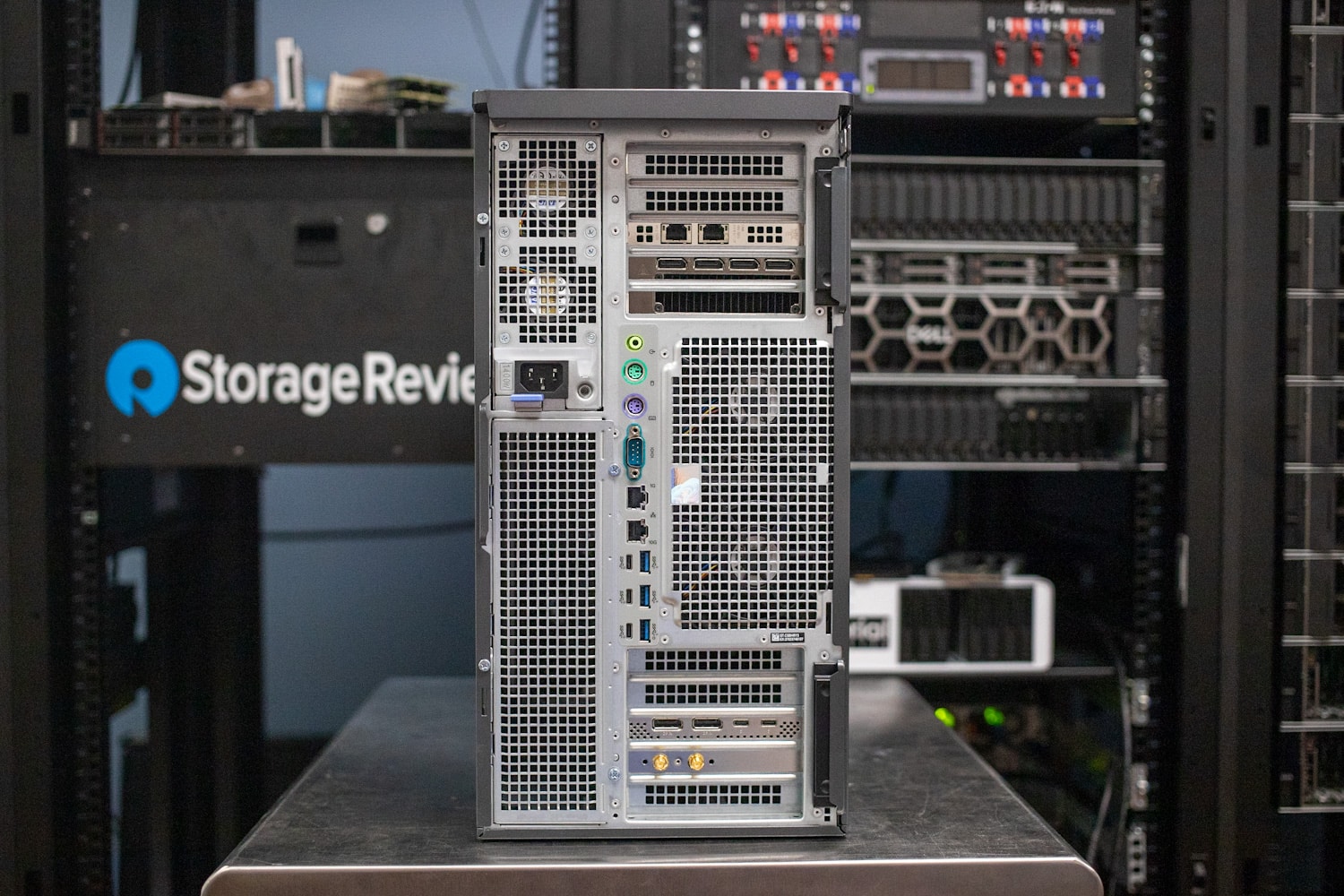
Dell Precision 7960 Specifications
Regarding hardware configuration, the Precision 7960 offers a wide range of options as usual. The nine options for CPU, 42 options for GPU, 35 options for Memory, and numerous options for boot drives, storage drives, and their placement, and storage controllers make the 7960 perfect for various workloads.
On the high end, the Precision 7960 can be loaded with a Xeon w9-3495x 56 core, 112 thread CPU with a base clock of 1.9GHz, 4TB of DDR5 4800MHz in a 16x256GB configuration, and quad NVIDIA RTX 6000 Ada generation cards. Dell offers a variety of options for storage but notably has options for up to four hot-swap flexbays on the front panel and an additional four at the rear for SATA, SAS, or NVME.
Processor |
|
Graphics |
|
Memory |
|
Storage |
|
Storage Controllers |
|
Ports/Slots |
Front:
Rear:
Optical Drive:
Slots:
|
Networking |
Onboard Ethernet:
Optional Ethernet:
WLAN:
|
Add-in Cards |
|
Operating System |
|
Dimensions |
|
Weight |
|
Hardware Security |
|
Power Supply |
(1500W/2200W PSUs have C19 AC cord and require 20A circuit @115V or a 220V circuit Externally accessible/removable/lockable) |
ISV Certifications |
ISV Certifications can be found at: https://www.dell.com/precision/ISVCertification/ |
Dell Precision 7960 Build and Design
The Precision 7960 follows a similar design to its predecessor, the 7920, with the same hidden honeycomb design behind the grating in the front bezel. The build is sleek yet beefy in its compact footprint. As mentioned above, Dell also offers a rackmount model.
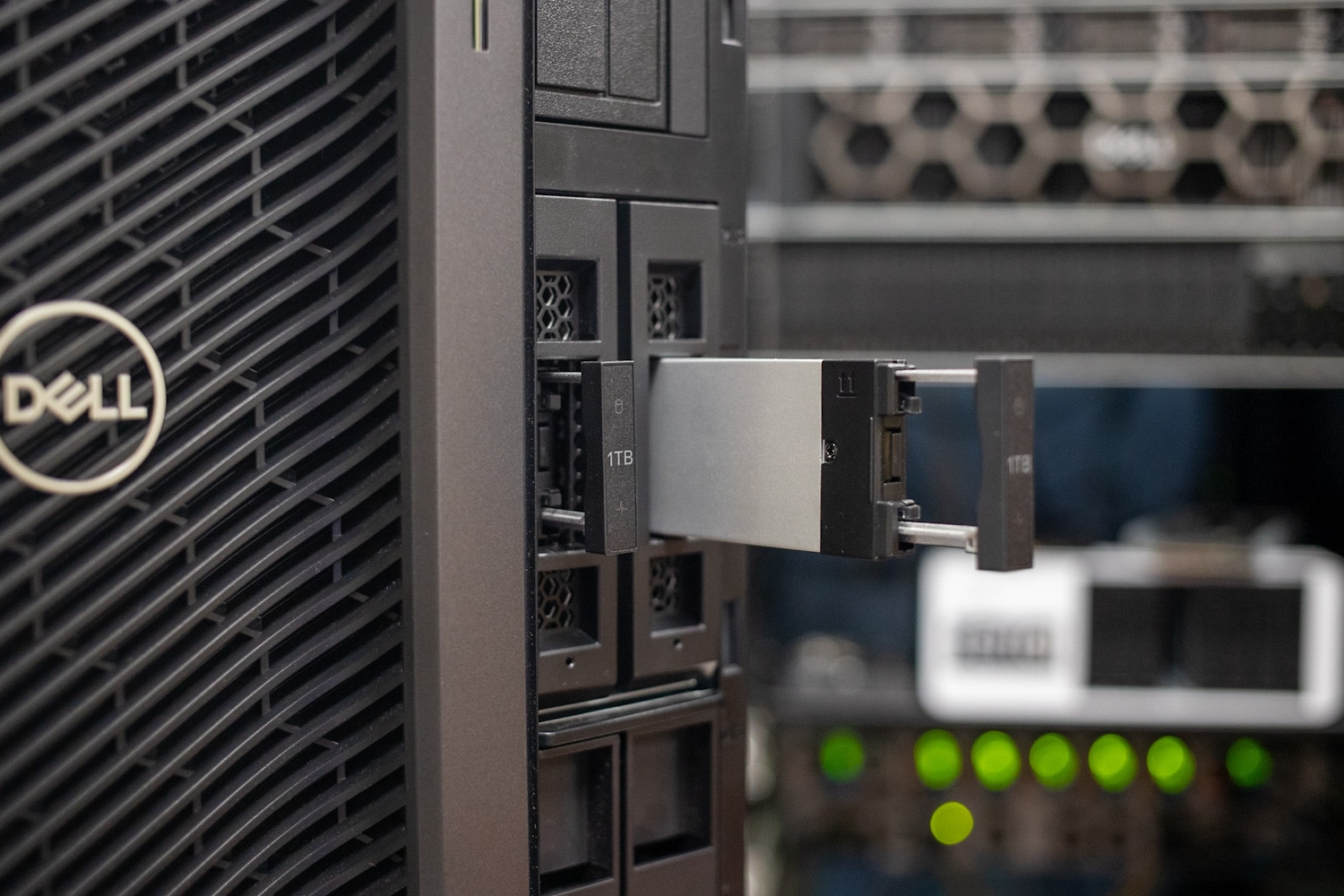
Dell designed the Precision 7960 to make it easy to service with everything, including the boot storage, quickly accessible from the front. The M.2 NVMe SSDs have moved to the front bays with quick-release sleds, allowing full access without cracking open the case. Dell offers options to have all four front bays in the same flexbay configuration, alongside SAS and SATA options.
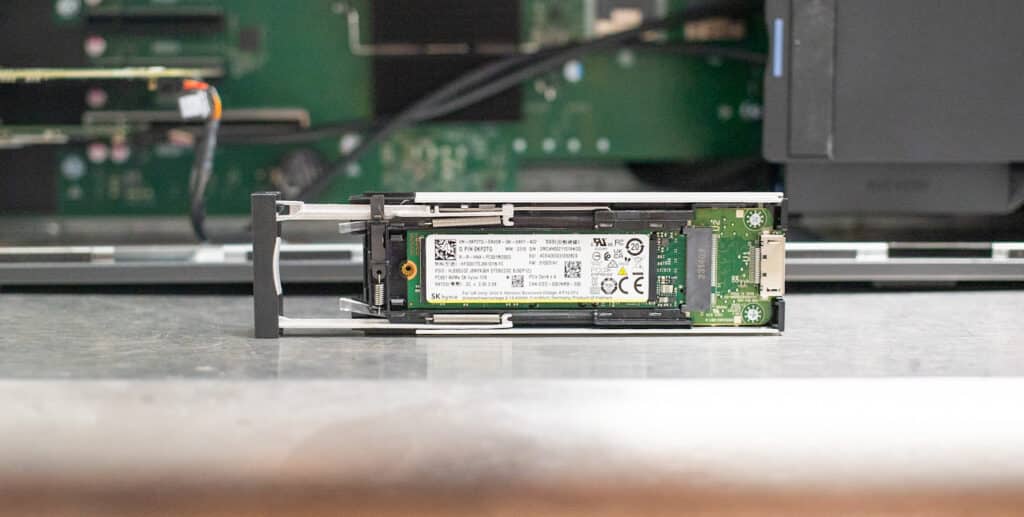
Underneath the power supply on the 7960, there are an additional four flex bays available allowing for more NVMe, M.2, SAS, or SATA storage with the appropriate storage controllers onboard.
The FlexBay SSD carriers allow you to have NVMe storage that is easily upgradable. The carriers hold an M Key 2280 M.2 NVMe SSD allowing various options for storage.
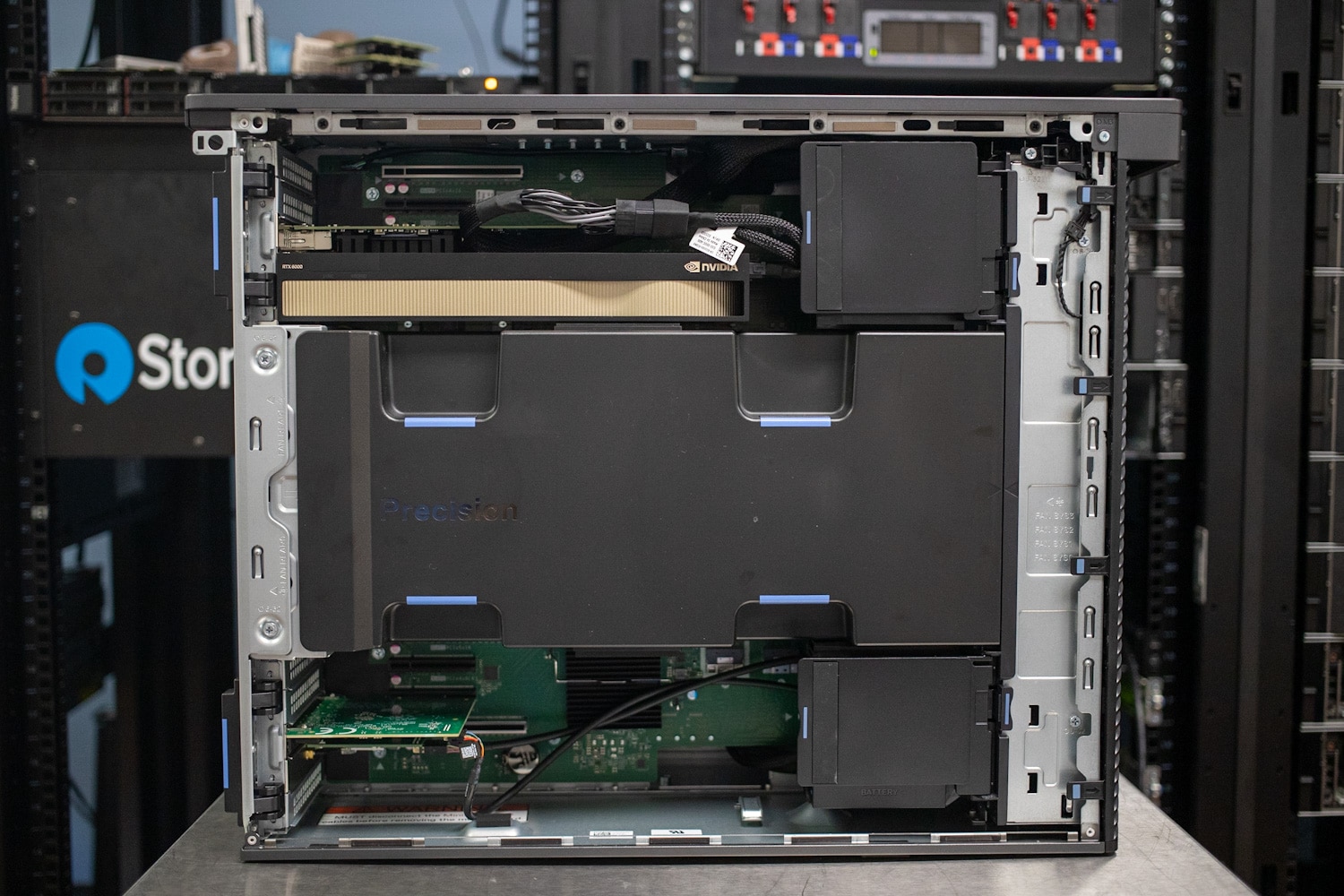
With the side panel removed from the chassis, you first see the large air ducting across the CPU and DRAM. This helps keep hot air in a channel around the CPU and directs it out of the case, away from other components. It is also configured to move air across the DRAM slots for optimal performance.
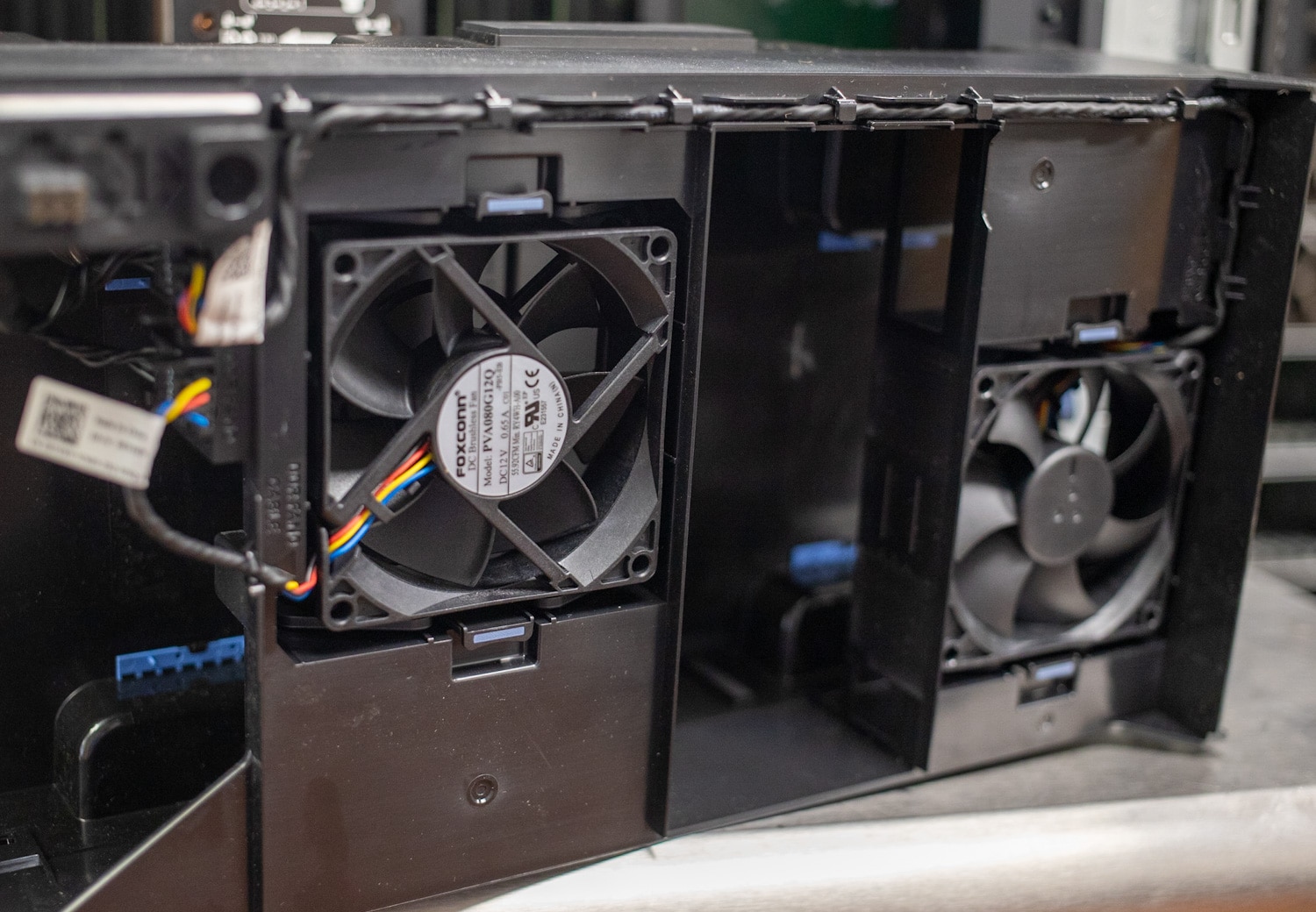
Overall, the inside of the case is neatly laid out, with excess wiring kept out of the way to prevent impeding airflow. You can see the heatsink covering the beast of a CPU alongside the 16 DIMM slots. This view also really puts the RTX 6000 Ada on full display.
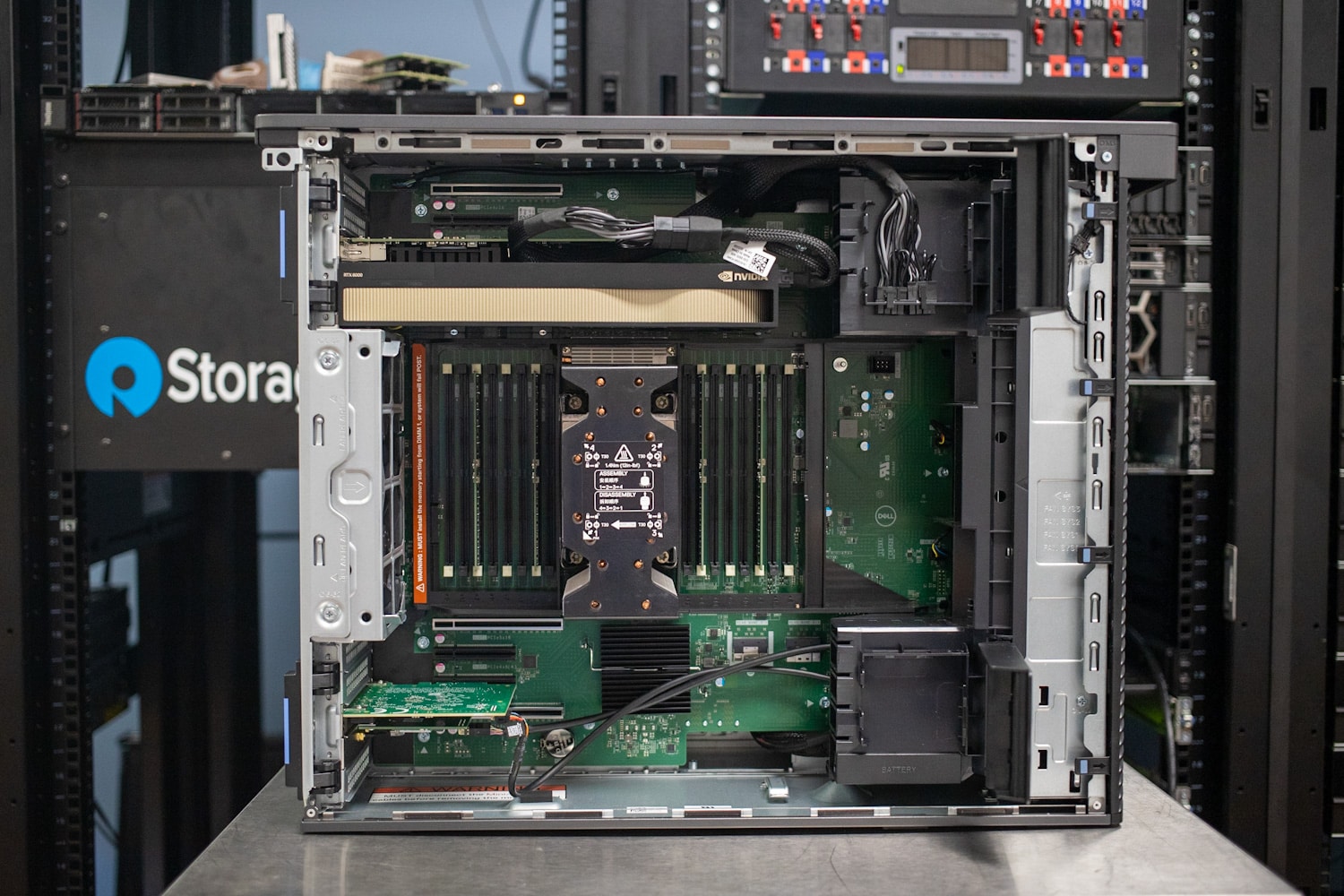
Dell offers plenty of connectivity across the back of the Precision 7960, even keeping legacy connections such as PS2 keyboard and mouse connections. Thunderbolt 4 connectivity is provided through the add-on card seen in the lower section of the case.
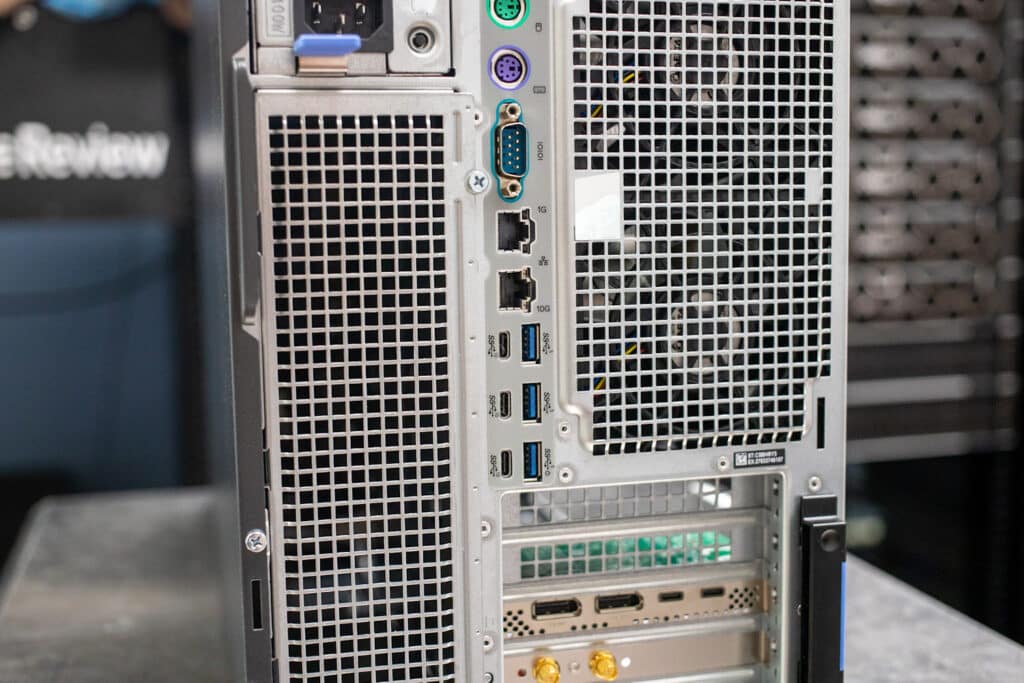
Continuing with the easy-to-service messaging, the power supply is swappable through the rear of the chassis. Similar to removing a PSU from a Dell server, you hit the release lever and pull the power supply out.
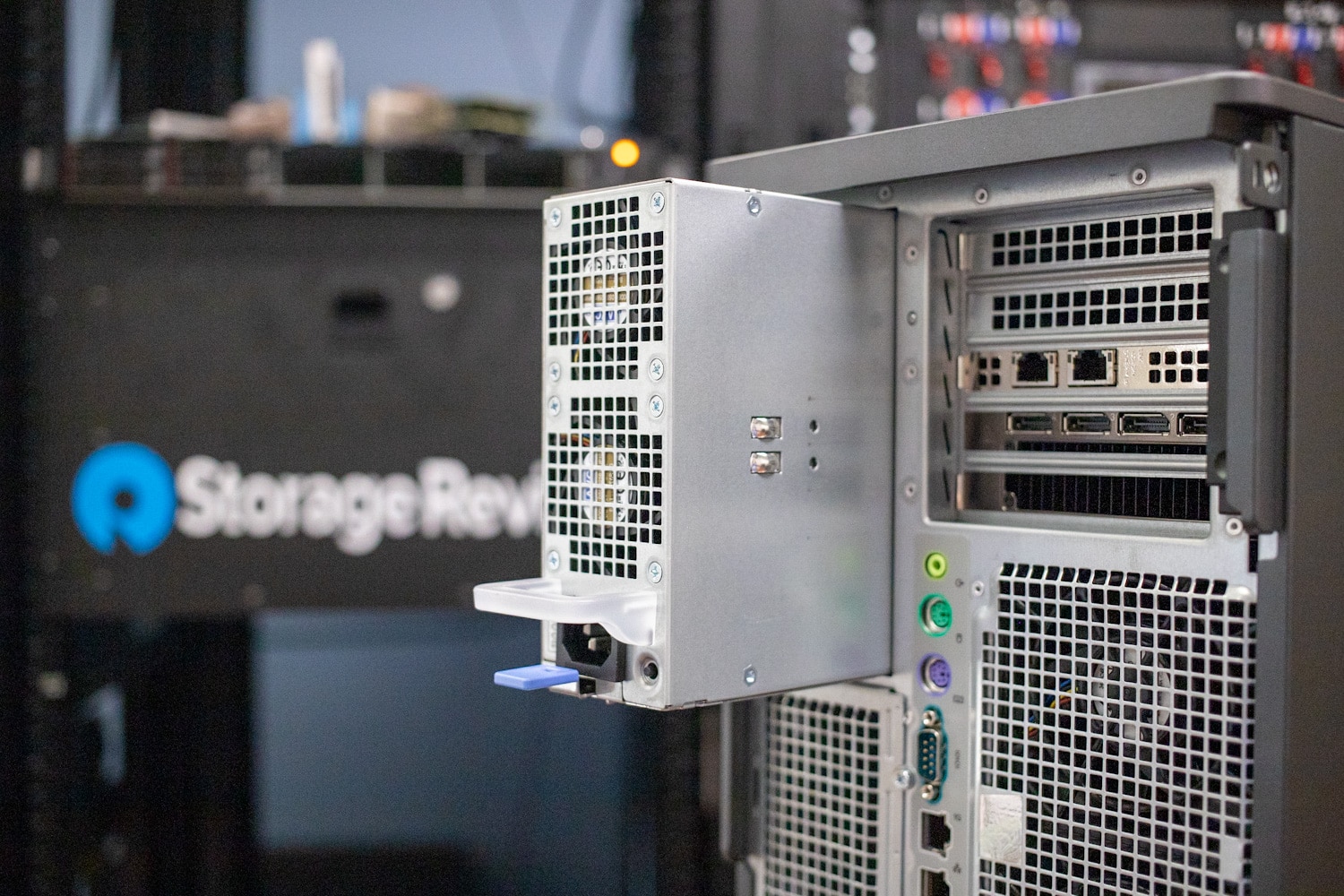
As mentioned earlier, the 7960 allows an additional four drives to be installed on the rear with a total of 8 easily accessible drives for loads of storage possibilities. The rear bays can be configured to support NVME, M.2, SAS, and SATA drives. Keep in mind though, you need to make sure the storage controller in your configuration supports the extra drives.
Dell Precision 7960 Performance
Specs as Reviewed
The unit we used to test is configured with the following specs:
- Intel Xeon w9-3495X Precision desktop featuring a 56 Core/ 112 Thread CPU with 105MB cache operating up to 4.8GHz
- 128GB of DDR5 ECC Memory (4x32GB)
- NVIDIA Ada Lovelace RTX A6000 with 48GB GDDR6 memory
- RAID 0 with 2x 1GB M.2 2280 Class 40 SSD
- Qualcomm WCN6856-DBS. 2×2, 802.11ax + Bluetooth wireless card
- 16X DVD+/-RW Slimline Optical Disk
- Thunderbolt 4 PCIe card
- Tested unit price: $19,765
- Base unit price: $4,879
With all the options available for the 7960, our unit fits in the middle-of-the-road category. It may not be a complete monster like the top-spec unit, but it still packs quite a punch. As always with Dell products, while the price tag may look lofty on Dell’s website, most units are sold through channel partners that can help with business pricing for bulk orders.
Benchmark Competitor Specs
In the benchmarks, we set up the 7960 against the Precision 7865, which is slightly different in its top-spec capabilities and runs an AMD Threadripper CPU instead of the Xeon. The 7865 is also positioned as a lighter workstation than the 7960 regarding maximum configurations.
The configuration for the 7865 from our earlier review included:
- AMD Threadripper Pro 5995WX (64 cores, 128 threads, 280W)
- NVIDIA RTX A6000 (48GB)
- 64GB DDR4-3200 ECC (8x 8GB)
- 2x 1TB Gen4 SSD RAID0 (Dell Class 40)
This should set up a pretty fair fight between the two machines when it comes to CPU, as the Threadripper has a base clock of 2.7GHz and a boost clock of up to 4.5GHz compared to the Xeon w9-3495x with a base clock of 1.9GHz but a max boost clock of 4.8GHz, though the 7865 does have less RAM. These machines are also competing between the RTX 6000 Ada on the 7960 and the RTX A6000 on the 7865. Though the naming scheme is close, and both cards share the same 48GB of VRAM, these cards perform pretty differently.
Specview Perf 2020
Our first test is SPECviewperf 2020, the worldwide standard for measuring the graphics performance of professional applications under the OpenGL and Direct X application programming interfaces. The viewsets (or benchmarks) represent graphics content and behavior from actual applications without having to install the applications themselves. The newest version of this benchmark went through some major updates late last year, including new viewsets taken from traces of the latest versions of 3ds Max, Catia, Maya, and Solidworks applications. In addition, they added support within all viewsets for both 2K and 4K resolution displays.
Both machines were run with a windowed resolution of 3800×2120.
Being a very GPU-intensive benchmark, this test shows the real difference between the A6000 and the A6000 Ada and how, even though they have the same 48GB of VRAM, the difference in CUDA cores shows itself in performance.
| SPECviewperf2020 Viewsets (Higher is better) | Dell Precision 7960 (Xeon W9-3495X, 128GB DDR5, RTX A6000 Ada 48GB) | Dell Precision 7865 (AMD 5995WX, 64GB DDR4, RTX A6000) |
| 3dsmax-07 | 218.62 | 140.79 |
| Catia-06 | 114.68 | 100.57 |
| Creo-03 | 128.74 | 137.39 |
| Energy-03 | 84.46 | 42.95 |
| Maya-06 | 424.08 | 334.18 |
| Medical-03 | 74.16 | 35.98 |
| Snx-04 | 932.85 | 453.83 |
| Solidworks-05 | 299.69 | 170.08 |
Blender OptiX
Blender is an open-source 3D modeling application. This benchmark was run using the Blender Benchmark utility. The score is samples per minute, with higher being better.
The Precision 7960’s RTX A6000 Ada predictably proved itself firmly in this test again, with it being another GPU-intensive test.
| Blender OptiX (Samples per minute, Higher is better) | Dell Precision 7960 (Xeon w9-3495X, 128GB DDR5, RTX A6000 Ada 48GB) | Dell Precision 7865 (AMD 5995WX, 64GB DDR4, RTX A6000) |
| Monster | 6,709.22 | 2,839 |
| Junkshop | 3,165.46 | 1,595 |
| Classroom | 3176.04 | 1,384 |
Luxmark
Another 3D benchmark we will look at is LuxMark, an OpenCL GPU benchmarking utility. Again, the Precision 7960’s RTX A6000 Ada showed its strength over the RTX A6000 the 7865 brings.
| Luxmark (Higher is better) | Dell Precision 7960 (Xeon w9-3495X, 128GB DDR5, RTX A6000 Ada 48GB) | Dell Precision 7865 (AMD 5995WX, 64GB DDR4, RTX A6000) |
| Hallbench | 31,731 | 20,991 |
| Food | 13,471 | 7,866 |
ESRI
Next up is the Environmental Systems Research Institute (Esri) benchmark. Esri is a supplier of Geographic Information System (GIS) software. Esri’s Performance Team designed their PerfTool add-in scripts to launch the ArcGIS Pro automatically. This application uses a “ZoomToBookmarks” function to browse various predefined bookmarks and create a log file with all the key data points required to predict the user experience. The script automatically loops the bookmarks three times to account for caching (memory and disk cache). In other words, this benchmark simulates heavy graphical use that one might see through Esri’s ArcGIS Pro software.
The tests consist of three main datasets. Two are 3-D city views of Philadelphia, PA, and Montreal, QC. These city views contain textured 3-D multipatch buildings draped on a terrain model and draped aerial images. The third dataset is a 2-D map view of the Portland, OR region. This data contains detailed information for roads, land use parcels, parks and schools, rivers, lakes, and hill-shaded terrain.
The Precision 7960 performed predictably well in this test with its A6000 Ada over the 7865’s RTX A6000, but the gap was smaller than in other tests.
First up is the Montreal model:
ESRI ArcGIS Pro 2.3 Montreal |
|
| Average FPS | Average |
| Dell Precision 7960 (Xeon W9-3495X, 128GB DDR5, RTX A6000 Ada 48GB) | 809.92 |
| Dell Precision 7865 (AMD 5995WX, 64GB DDR4, RTX A6000) | 574.46 |
| Minimum FPS | Average |
| Dell Precision 7960 (Xeon W9-3495X, 128GB DDR5, RTX A6000 Ada 48GB) | 345.45 |
| Dell Precision 7865 (AMD 5995WX, 64GB DDR4, RTX A6000) | 272.18 |
Next is the Philly model:
ESRI ArcGIS Pro 2.3 Philly |
|
| Average FPS | Average |
| Dell Precision 7960 (Xeon w9-3495X, 128GB DDR5, RTX A6000 Ada 48GB) | 603.84 |
| Dell Precision 7865 (AMD 5995WX, 64GB DDR4, RTX A6000) | 451.09 |
| Minimum FPS | Average |
| Dell Precision 7960 (Xeon w9-3495X, 128GB DDR5, RTX A6000 Ada 48GB) | 321.11 |
| Dell Precision 7865 (AMD 5995WX, 64GB DDR4, RTX A6000) | 254.78 |
Last is the Portland model:
ESRI ArcGIS Pro 2.3 Portland |
|
| Average FPS | Average |
| Dell Precision 7960 (Xeon w9-3495X, 128GB DDR5, RTX A6000 Ada 48GB) | 2172.16 |
| Dell Precision 7865 (AMD 5995WX, 64GB DDR4, RTX A6000) | 1986.56 |
| Minimum FPS | Average |
| Dell Precision 7960 (Xeon w9-3495X, 128GB DDR5, RTX A6000 Ada 48GB) | 1270.35 |
| Dell Precision 7865 (AMD 5995WX, 64GB DDR4, RTX A6000) | 1280.95 |
OctaneBench
Next, we look at OctaneBench, a benchmarking utility for OctaneRender, another 3D renderer with RTX support similar to V-Ray. This gives adequate space for the RTX A6000 Ada to stretch its legs and demonstrates the performance differences between it and its RTX A6000 counterpart, clearly showing the differences that the A6000 Ada brings with 18,176 Cuda cores vs. the A6000’s 10,752 CUDA cores.
| OctaneBench (Score, higher is better) | Kernel | Dell Precision 7960 (Xeon w9-3495X, 128GB DDR5, RTX A6000 Ada 48GB) | Dell Precision 7865 (AMD 5995WX, 64GB DDR4, RTX A6000) |
| Interior | Info channels | 42.64 | 18.39 |
| Interior | Direct lighting | 125.49 | 66.64 |
| Interior | Path tracing | 156.94 | 86.40 |
| Idea | Info channels | 24.40 | 11.33 |
| Idea | Direct lighting | 99.20 | 52.14 |
| Idea | Path tracing | 118.34 | 64.19 |
| ATV | Info channels | 67.51 | 28.75 |
| ATV | Direct lighting | 127.96 | 74.09 |
| ATV | Path tracing | 161.16 | 93.20 |
| Box | Info channels | 34.24 | 15.60 |
| Box | Direct lighting | 119.04 | 66.25 |
| Box | Path tracing | 130.36 | 75.01 |
Blackmagic RAW Speed Test
We have also started running Blackmagic’s RAW speed test, which tests video playback performance. Additionally, this test is more of a hybrid test pooling both CPU and GPU in a Real-World scenario for RAW decoding. Again, the scores were pretty close with this one, but the 7960 still pulled ahead.
| Blackmagic RAW Speed Test (Higher is better) | Dell Precision 7960 (Xeon w9-3495X, 128GB DDR5, RTX A6000 Ada 48GB) | Dell Precision 7865 (AMD 5995WX, 64GB DDR4, RTX A6000) |
| 8K CPU | 124 FPS | 122 FPS |
| 8K CUDA | 194 FPS | 153 FPS |
7-Zip Compression
The built-in memory benchmark in the popular 7-Zip utility demonstrates the CPU performances of each machine well. The Threadripper in the 7865 started to show its teeth here compared to the Xeon W9-3495X in the 7960. We run this test at a 128MB dictionary size when possible.
| 7-Zip Compression Benchmark (Higher is better) | Dell Precision 7960 (Xeon w9-3495X, 128GB DDR5, RTX A6000 Ada 48GB) | Dell Precision 7865 (AMD 5995WX, 64GB DDR4, RTX A6000) |
| Current CPU Usage | 3279% | 3302% |
| Current Rating/Usage | 6.917 GIPS | 6.913 GIPS |
| Current Rating | 226.810 GIPS | 228.231 GIPS |
| Resulting CPU Usage | 3316% | 3293% |
| Resulting Rating/Usage | 6.934 GIPS | 6.973 GIPS |
| Resulting Rating | 229.905 GIPS | 229.630 |
| Decompressing | ||
| Current CPU Usage | 6106% | 6181% |
| Current Rating/Usage | 3.760 GIPS | 5.265 GIPS |
| Current Rating | 229.591 GIPS | 325.422 GIPS |
| Resulting CPU Usage | 5860% | 6188% |
| Resulting Rating/Usage | 2.954 GIPS | 5.265 GIPS |
| Resulting Rating | 231.485 GIPS | 325.813 GIPS |
| Total Rating | ||
| Total CPU Usage | 4588% | 4740% |
| Total Rating/Usage | 5.444 GIPS | 6.119 GIPS |
| Total Rating | 230.695 GIPS | 277.721 GIPS |
Geekbench 6
Geekbench 6 is a cross-platform benchmark that measures overall system performance. Though it would be interesting to look at the Single core vs. Multi-Core performance between the two machines, we only have numbers for the Precision 7960 in this test. Still, you can find comparisons to any system you want in the Geekbench Browser. Higher scores are better.
| Geekbench 6 | Dell Precision 7960 (Xeon w9-3495X, 128GB DDR5, RTX A6000 Ada 48GB) |
| CPU Benchmark – Single-Core | 2302 |
| CPU Benchmark – Multi-Core | 18157 |
| GPU Benchmark – OpenCL | 303158 |
Cinebench R23
Maxon’s Cinebench R23 is a CPU rendering benchmark that utilizes all CPU cores and threads. We ran it for both multi- and single-core tests. This is another benchmark where we only have numbers for the Precision 7960, but CPU reviews from major sites will have results from this test. Higher scores are better.
| Cinebench R23 | Dell Precision 7960 (Xeon w9-3495X, 128GB DDR5, RTX A6000 Ada 48GB) |
| CPU (Multi-Core) | 58,774 Points |
| CPU (Single-Core) | 1,689 Points |
| MP Ratio | 34.79x |
UL Procyon AI Inference
UL’s Procyon estimates a workstation’s performance for professional apps. We ran the AI Inference test for both Windows Machine Learning on CPU and GPU and NVIDIA Tensor RT. This is another test we do not have scores on for the 7865. Lower times are better, and higher overall scores are better.
| UL Procyon Average Inference Times | Xeon w9-3495X Windows ML | RTX A6000 Ada – GPU Windows ML | RTX A6000 Ada – GPU NVIDIA Tensor RT |
| MobileNet V3 | 2.22 | 0.54 | 0.59 |
| ResNet 50 | 6.27 | 0.95 | 0.99 |
| Inception V4 | 29.41 | 2.32 | 3.42 |
| DeepLab V3 | 24.27 | 26.87 | 2.95 |
| YOLO V3 | 37.83 | 5.34 | 2.68 |
| REAL-ESRGAN | 1527.68 | 86.18 | 84.15 |
| Overall Score | 173 | 1009 | 1506 |
y-cruncher
y-cruncher is a multi-threaded and scalable program that can compute Pi and other mathematical constants to trillions of digits. Since its launch in 2009, y-cruncher has become a popular benchmarking and stress-testing application for overclockers and hardware enthusiasts. Faster is better in this test, and we only have results for the 7960 here.
| y-cruncher (Total Computation time) | Dell Precision 7960 – Xeon w9-3495X, 128GB DDR5, RTX A6000 Ada 48GB |
| 1 billion digits | 12.788 Seconds |
| 2.5 billion digits | 34.459 Seconds |
| 10 billion digits | 157.770 Seconds |
Conclusion
Overall, 7960 Performed well against the 7865 in our testing; though they were not in the same class, the configurations we received put up pretty good numbers, showing each has its strengths and weaknesses. Additionally, we noted that the 7960 was quiet in all tests unless the fans were needed. There is minimal fan noise until it gets to a heavy load; then, it will ramp up to an appropriate RPM.
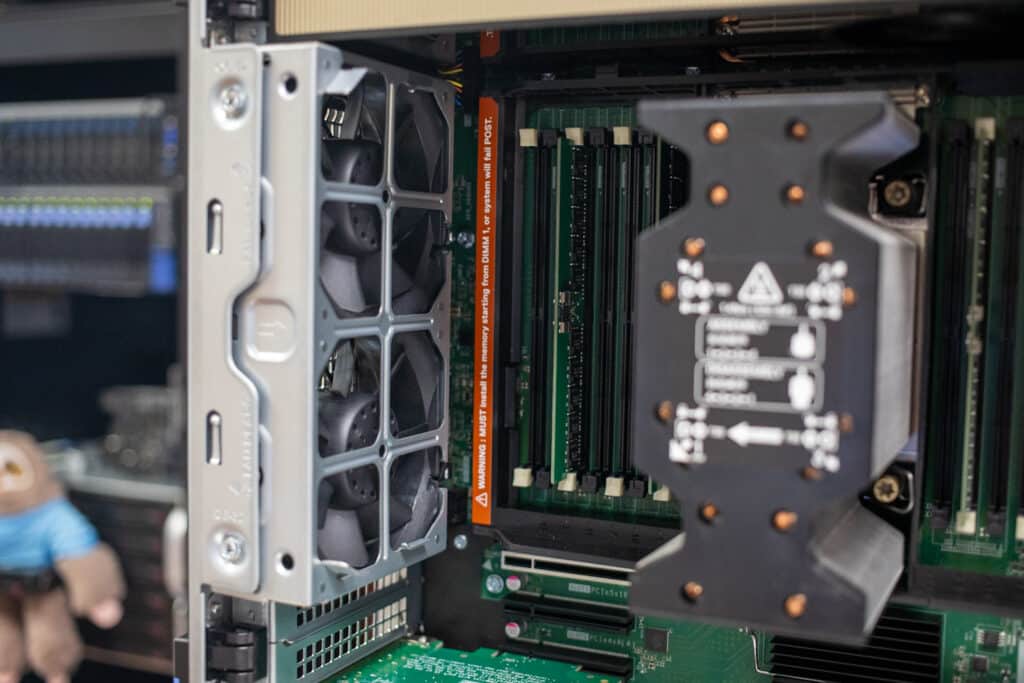
Overall, the Precision 7960 is an absolute workhorse of a desktop machine that can be set up for all sorts of workloads, and it shows itself in our testing. Still, our unit wasn’t even at its full potential with the configuration we have on hand, and the performance from the top-spec model would be even more impressive in the numbers it would put out. The sheer amount of different configuration options, like rack or tower configs, open it up to different needs and workloads, bringing the 7960 into the scope of a wide range of professional users.
Engage with StorageReview
Newsletter | YouTube | Podcast iTunes/Spotify | Instagram | Twitter | TikTok | RSS Feed

